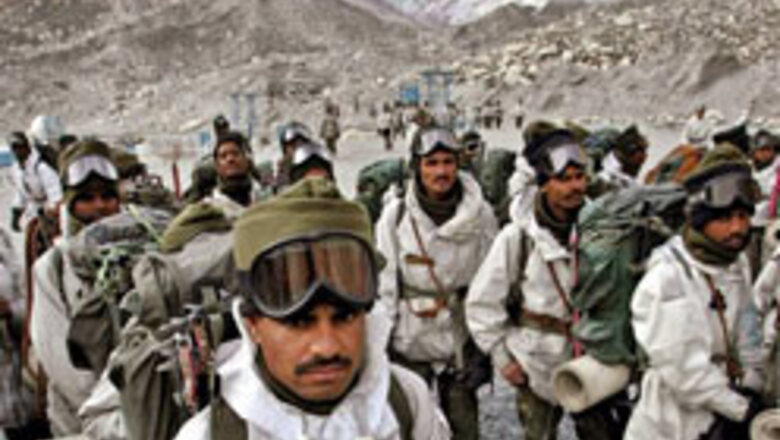
views
New Delhi: Pakistan Foreign Minister Khurshid Mehmood Kasuri has reiterated that a solution to the Siachen issue is in sight, but Indian officials have expressed scepticism over the statement.
"The differences have been narrowed down. Given the political will, the dispute can be resolved in a matter of weeks, if not days," Kasuri told a news channel.
Indian officials said Kasuri was only attempting to hype the Siachen issue ahead of the talks between the foreign secretaries of the two countries beginning here on Tuesday.
This was because Islamabad wanted to shift the focus away from the fight against terror—an issue that New Delhi wants to bring to the forefront in the light of the joint mechanism Prime Minister Manmohan Singh and Pakistani President Pervez Musharraf agreed to at the their meeting on the sidelines of the Non-Aligned Movement summit at Havana in August.
More importantly, Indian officials said, Islamabad is unwilling to certify ground realities on what is regarded as the world's highest and coldest battlefield. On its part, the Indian Army has made it amply clear it wants these ground realities to be certified.
Indian troops currently occupy advantageous positions along the 76-km-long glacier and New Delhi says Islamabad must accept the actual ground position line (AGPL) before pulling back its forces that have been on station on the glacier since 1984.
For Pakistan to do so would, in effect, amount to accepting the AGPL as the international border (IB), which would mean a total reversal of its stand that Indian troops retreat to the positions they held in 1972 as laid down by the Simla Agreement of the previous year.
This, India says, would negate the very reasons it sent its troops into Siachen in 1984 to nullify Pakistani designs on the glacier, which rises to a height of 22,000 feet and where winter temperatures plunge to -50 degrees Celsius.
The first detachments of Indian troops landed at the 16,000-foot Bilafond La on the Saltoro Ridge April 13, 2004 and at the slightly higher Sia La four days later to prevent Pakistani forces from getting a toehold in the area.
Since then, the two sides have been engaged in a bitter standoff, with a truce having been declared in the area since 2003.
It's not just the heights India commands. Siachen serves as a strategic wedge between Pakistani and Chinese troops deployed on their borders with India. Military analysts warn that any Indian pullback - without guarantees of the AGPL being respected - would enable the two armies link up and threaten the Ladakh valley to the south and even the Kargil region.
Given this scenario - and given the fact that the Indian Army has made it amply clear it cannot retake the heights if it pulls back without guarantees - no progress can be expected at the foreign secretaries' talks, military analysts said.
PAGE_BREAK
The Siachen standoff is one of eight issues covered under the composite dialogue process India and Pakistan have initiated to resolve bilateral issues, including Kashmir. The two sides had held six rounds of unsuccessful talks on Siachen before the issue was included in the composite dialogue process in 1998. The process then stalled and was revived in 2004. There was another hiccup after the July 11 Mumbai train bombings.
The process received fresh impetus after the Manmohan Singh-Musharraf meeting at Havana in August.
As for the Indian Army, it has made it clear that Pakistan has no claims on Siachen and that it requires concrete guarantees before it pulls back from its present positions.
"Pakistan has absolutely no claims over Siachen," maintained Brigadier Om Prakash, commander of the Indian Army formation responsible for guarding the area.
"Our troops are stationed at least 20-30 km west of the glacier. The Pakistanis cannot even get a look in, let alone lay claim to the glacier," he told a select group of journalists from New Delhi at the Siachen Base Camp.
What needs to be noted is that the AGPL relates not only to the 76 km of the Siachen Glacier but to another 34 km to a place called point NJ9842, where it abruptly stops. From here, India maintains the line that follows the Saltoro Ridge northwards, meaning the entire glacier falls within its territory.
Pakistan, however, has been citing a US map published in the mid-1970s showing the AGPL veering northeast up and down a series of mountain ridges to the Karakoram Pass to say the glacier runs within its territory.
"This is ridiculous," Om Prakash countered. "Boundaries run along ridges, not up and down mountains," he added, a view the Indian government has consistently taken on its border disputes with Pakistan and China.
Over 600 Indian soldiers have died in Siachen during the past 20 years, a majority of them victims of the extreme weather conditions in the area.
















Comments
0 comment